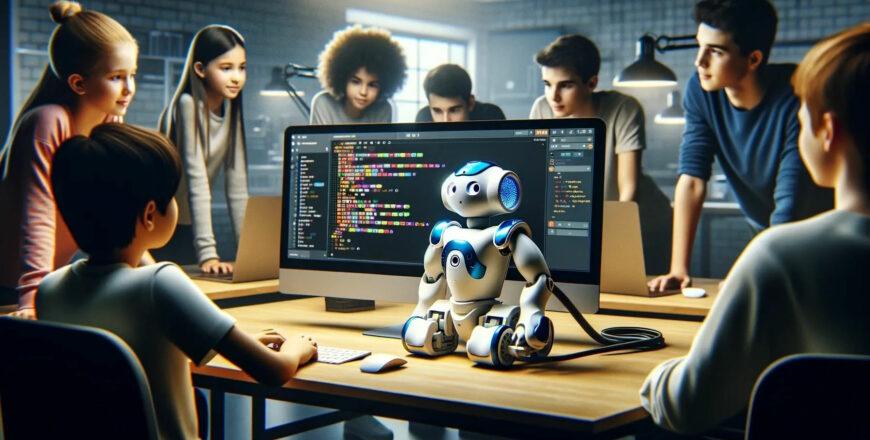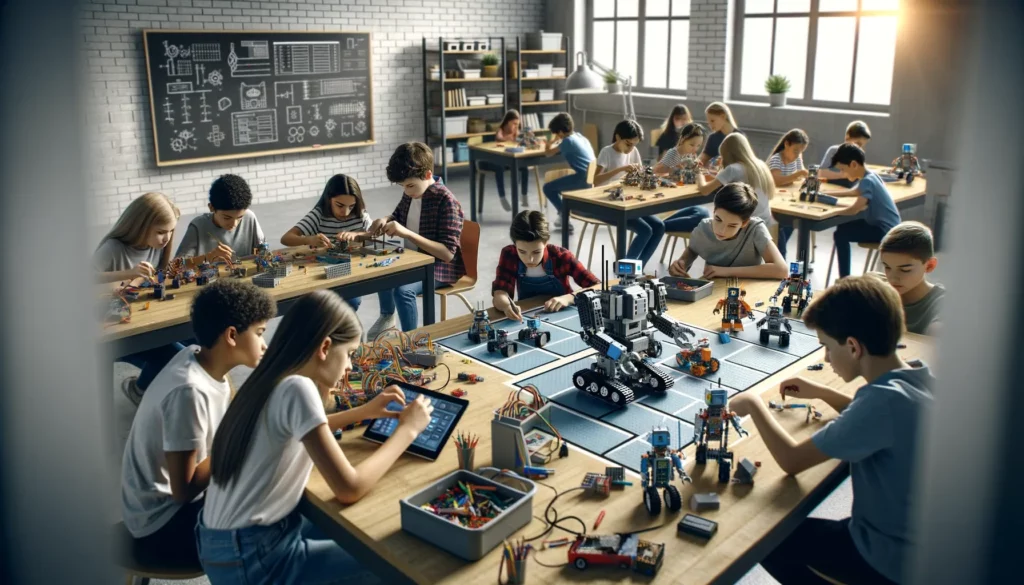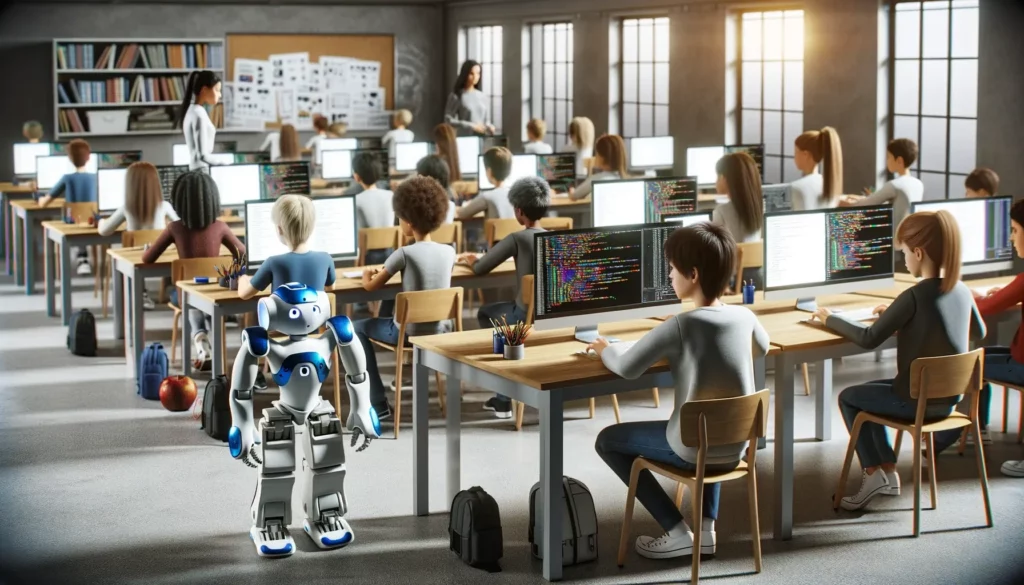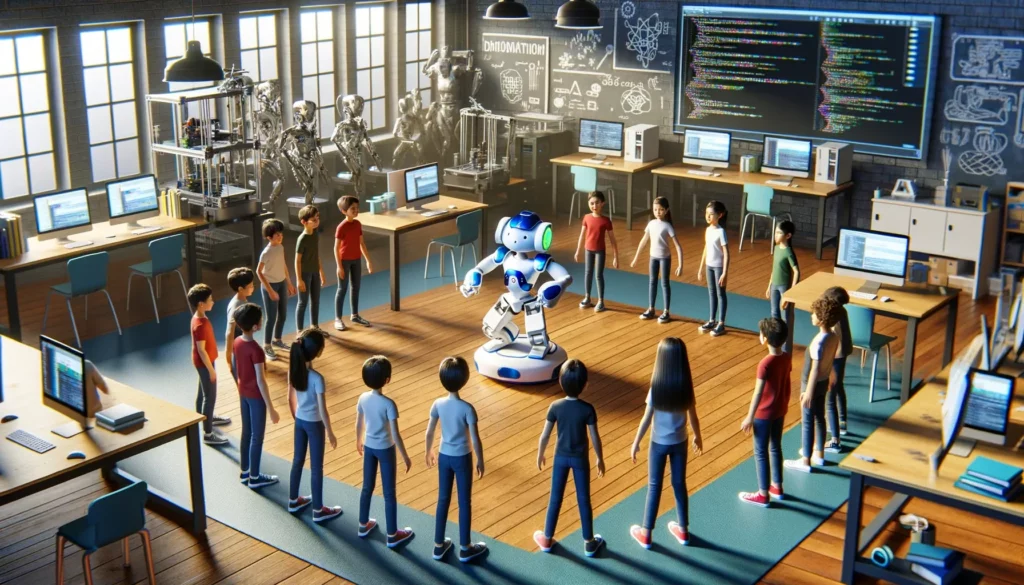🦾 STEM Lab Robotics Coding and Educational Robotics with 🤖 NAO Robot Simulator and others
- Description
- Curriculum
- Reviews

STEM Lab Robotics – Coding and Educational Robotics with NAO Robot Simulator and others
Welcome to the STEM Lab Robotics course for school students designed to immerse them in the dynamic realms of coding and educational robotics. This course isn’t just about glimpsing the future; it’s about actively engaging with the present landscape of technology. Robotics is integral to our daily lives, and understanding its nuances is key to thriving in tech-driven careers.
This course offers a multi-faceted educational experience, blending technical, and humanistic perspectives. Focusing primarily on the NAO Robot, a humanoid robot perfect for student interaction, and covering a wide range of devices from LEGO to Micro:Bit, students will learn through engaging activities.
This course is set to revolutionize the way we think about robotics in society. Students will quickly master the basics of Python and other languages through a user-friendly block coding system, ideal for beginners and young learners. This course promises to transform programming into a fun and intuitive experience.

Advantages for Educators and Parents
“STEM Lab Robotics” is an invaluable resource for educators and parents. It provides a versatile platform for students to excel in coding and robotics, irrespective of the availability of physical robots. With a focus on multidisciplinary activities, educators can use this course to integrate robotics into various subjects, from using NAO to aid English language learning to applying robotics principles in physical education classes to teach movement and balance. The Robot Coding Simulator enables the programming of various robotic systems, ensuring inclusive and comprehensive education even in resource-limited settings. This approach is instrumental in fostering a holistic and diverse learning environment.
Robots You Can Program, Simulate, and Use
The simulator features a diverse range of robots, each offering unique learning experiences. From the BOB3, perfect for hands-on tinkering and programming enthusiasts, to the versatile micro:bit V2, ideal for environmental studies with its sensor capabilities. Students can explore mobile industrial robotics with Robotino, delve into AI with Roberta xNN, or bring their creative ideas to life with LEGO EV3 and SPIKE Prime. These varied platforms, including Thymio, Arduino, and Edison, provide practical insights into the world of robotics, catering to different educational needs and interests.

Course Module
Introduction to Educational Robotics and the Robot Coding Simulator
Gain a foundational understanding of educational robotics and master the Robot Coding Simulator. This module is crucial for grasping the significance of robotics in education and becoming adept with the simulator.
Basics of Programming
Delve into fundamental programming concepts like loops, variables, and conditions. This module offers hands-on coding exercises to solidify foundational programming knowledge.
Understanding Robotics Hardware
Learn about the components that power robots, focusing on sensors, motors, and controllers. This module provides valuable practical knowledge about the hardware aspects of robotics.
Programming the Robot
Apply coding skills to program virtual robots. This module teaches basic movements and sensor interactions, effectively combining theory with practical application.
Advanced Programming Concepts
Explore complex programming structures like loops and conditional statements. This module enhances problem-solving abilities and prepares students for advanced robotics challenges.
Robotics in Real Life
Discover how robotics revolutionizes various industries and delve into ethical and safety aspects. This module offers real-world perspectives on robotics applications.
Robot Coding Simulator in deep
Become proficient with the Robot Coding Simulator, exploring its features thoroughly. This module ensures students can fully utilize the simulator for enhanced learning.
NAO Robot Programming and Intro to Python
Experience the world of humanoid robotics with an introduction to programming the NAO robot. This module combines Python and NEPO programming for a real-world application.
Spike Prime / Robot Inventor Programming and Intro to MicroPython
Engage with MicroPython programming for Spike Prime / Robot Inventor robots. This comprehensive module enhances students’ programming skills on versatile robotics platforms.

Join now!
Join “STEM Lab Robotics” and embark on an unparalleled educational journey. This course is perfect for students, educators, and parents eager to explore the captivating world of robotics programming. Enroll now and be part of a transformative experience, paving the way for a future rich in technological innovation and diverse educational opportunities.
-
1🟢👉 SKS Online Course guide, tips, and emojis meaning list
Start from here, with our online course guide, tips, and emojis meaning list
-
2🆕🦾 History and evolution of Mechatronics and Robotics
The history of mechatronics and robotics can be traced back to the early 20th century, when the first mechanical robots were developed. These early robots were relatively simple machines that were used for manufacturing and assembly tasks in factories.
-
3🆕🦾💻 What is Robot Coding Simulator LAB
Robot Coding Simulator LAB is an online programming platform that allows users to program robots and other devices using the programming language Java. It is designed to be user-friendly and easy to use, making it an ideal platform for beginners and educators who want to learn more about programming and robotics.
-
4💻🦾🎓 Features and benefits of using Robot Coding Simulator LAB for Mechatronics and Robotics education
Robot Coding Simulator LAB is a powerful and user-friendly platform that is ideal for mechatronics and robotics education. It offers a range of features and benefits that make it an excellent choice for educators and students who want to learn more about programming and robotics.
-
5🔴🆕🦾💻 How to access and use Robot Coding Simulator LAB
A practical guide on how to access and effectively use the Robot Coding Simulator LAB for educational purposes
-
6🆕🦾💻 The virtual robotics hardware available in Robot Coding Simulator LAB
The virtual robotics hardware available in Robot Coding Simulator LAB provides a wide range of options for creating and testing programs for robots. Whether you are interested in programming a humanoid robot, a microcontroller board, or a LEGO robot, Robot Coding Simulator LAB has a virtual hardware option that can help you get started.
-
7🆕🦾💻 The programming languages and software tools available in Robot Coding Simulator LAB
The programming languages and software tools available in Open Roberta LAB provide a wide range of options for creating and testing programs for robots. Whether you are a beginner or an experienced programmer, Robot Coding Simulator LAB has a tool that can help you get started.
-
8🆕🦾💻 How to connect virtual robots to sensors and actuators in Robot Coding Simulator LAB
In Robot Coding Simulator LAB, virtual robots can be connected to sensors and actuators using the virtual hardware interface
-
9🤖🦾🎧 Introduction to robotics, intelligent agents and difference between Robotics and AI
In this lesson, we will explore the role of AI in enabling robots to overcome the challenges of localization, planning, and manipulation. We will discuss various AI techniques that are used in robotics, including machine learning and symbolic AI, and how these techniques are applied to enable robots to perform tasks effectively and efficiently. We will also discuss the increasing use of robots in various industries and applications and the role that AI plays in enabling their capabilities. By the end of this lesson, you will have a good understanding of the relationship between robotics and AI, and how these fields are working together to enable the development of increasingly capable robots.
-
10🆕🦾🎧💡 Advantages of using Robots in space
Robots have already begun to play a significant role in space exploration. In the future, it is likely that robots will continue to play an even larger role, potentially even replacing humans in some tasks.
-
11🆕🦾💻🎧 Using LEGO MINDSTORMS EV3 Sensor, line following task and play around
This lesson provides an introduction to the use of sensors in robotics and how to use them to create programs in Robot Coding Simulator LAB. It is designed to help beginners understand the basics of programming and robotics and how to use these tools to develop their own programs and projects.
-
12🆕🦾💻🎧 Using the ultrasonic sensor in EV3 Robot Coding Simulator LAB to control the distance of a robot and avoid obstacles
Using the ultrasonic sensor in Robot Coding Simulator LAB is a useful way to control the distance of a robot and avoid obstacles. By creating programs that use the "Ultrasonic" block and other blocks, we can create robots that can navigate through a course or perform other tasks while avoiding obstacles.

















